Amazon's Internationalization: Cultural Strategies and CSR Analysis
VerifiedAdded on 2023/06/16
|27
|5933
|271
Report
AI Summary
This report provides an in-depth analysis of Amazon's international management strategies, focusing on its success in internationalization, particularly in the United Kingdom. It identifies and discusses strategies for managing cultural differences using frameworks like Hofstede's dimensions and Trompenaars' seven dimensions, along with addressing the stages of culture shock. Furthermore, the report explores Amazon's strategies for corporate social responsibility, including community development, employee empowerment, economic investment, and environmental sustainability. Entry mode choices such as acquisition, partnership, and greenfield investment are also examined. The report addresses the tension between globalization and localization, offering recommendations for sustainable development through harnessing cultural diversity, community engagement, joint ventures, and proper localization, ultimately concluding with key insights for Amazon's continued international success. Desklib provides access to this and other solved assignments for students.
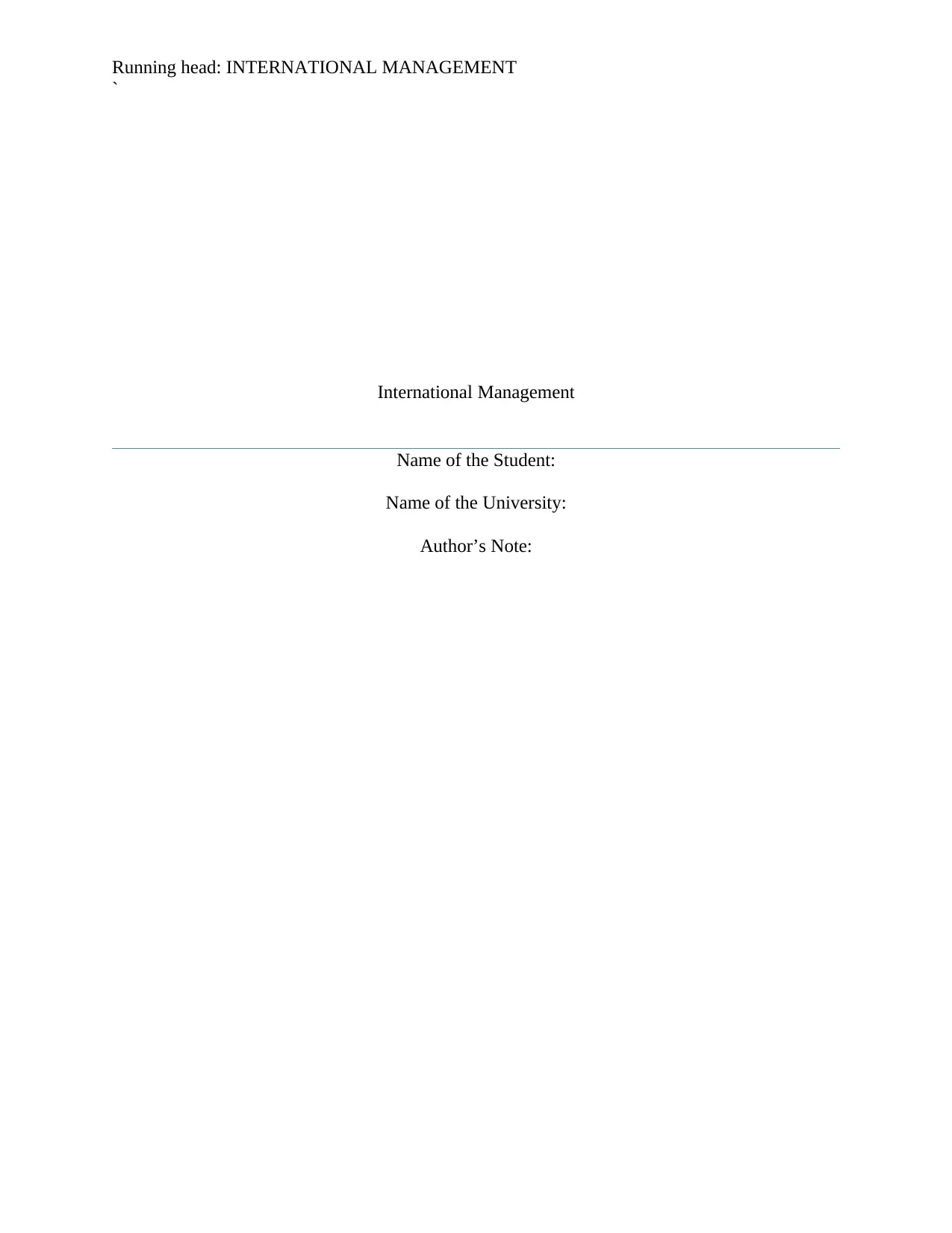
Running head: INTERNATIONAL MANAGEMENT
`
International Management
Name of the Student:
Name of the University:
Author’s Note:
`
International Management
Name of the Student:
Name of the University:
Author’s Note:
Paraphrase This Document
Need a fresh take? Get an instant paraphrase of this document with our AI Paraphraser
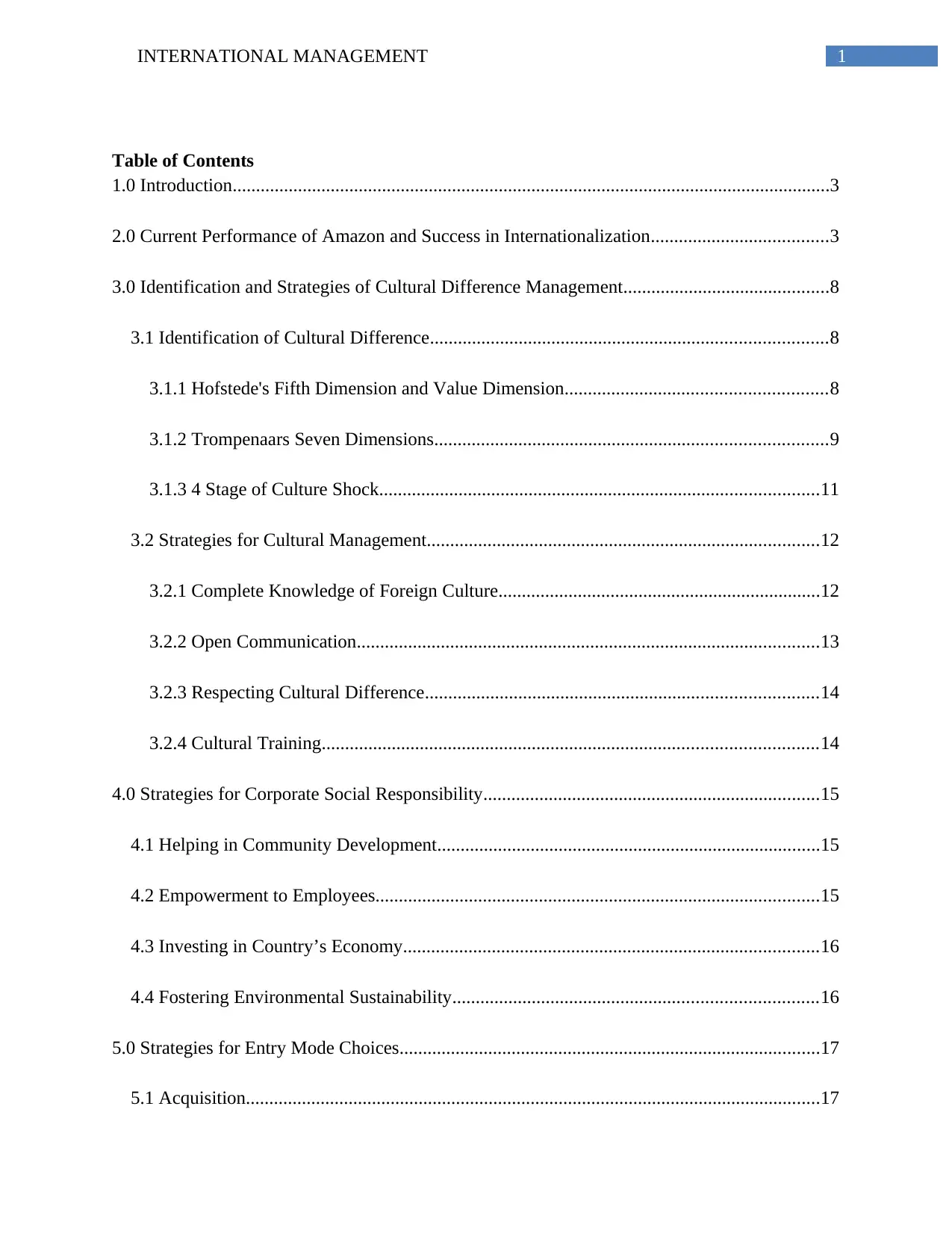
1INTERNATIONAL MANAGEMENT
Table of Contents
1.0 Introduction................................................................................................................................3
2.0 Current Performance of Amazon and Success in Internationalization......................................3
3.0 Identification and Strategies of Cultural Difference Management............................................8
3.1 Identification of Cultural Difference.....................................................................................8
3.1.1 Hofstede's Fifth Dimension and Value Dimension........................................................8
3.1.2 Trompenaars Seven Dimensions....................................................................................9
3.1.3 4 Stage of Culture Shock..............................................................................................11
3.2 Strategies for Cultural Management....................................................................................12
3.2.1 Complete Knowledge of Foreign Culture.....................................................................12
3.2.2 Open Communication...................................................................................................13
3.2.3 Respecting Cultural Difference....................................................................................14
3.2.4 Cultural Training..........................................................................................................14
4.0 Strategies for Corporate Social Responsibility........................................................................15
4.1 Helping in Community Development..................................................................................15
4.2 Empowerment to Employees...............................................................................................15
4.3 Investing in Country’s Economy.........................................................................................16
4.4 Fostering Environmental Sustainability..............................................................................16
5.0 Strategies for Entry Mode Choices..........................................................................................17
5.1 Acquisition...........................................................................................................................17
Table of Contents
1.0 Introduction................................................................................................................................3
2.0 Current Performance of Amazon and Success in Internationalization......................................3
3.0 Identification and Strategies of Cultural Difference Management............................................8
3.1 Identification of Cultural Difference.....................................................................................8
3.1.1 Hofstede's Fifth Dimension and Value Dimension........................................................8
3.1.2 Trompenaars Seven Dimensions....................................................................................9
3.1.3 4 Stage of Culture Shock..............................................................................................11
3.2 Strategies for Cultural Management....................................................................................12
3.2.1 Complete Knowledge of Foreign Culture.....................................................................12
3.2.2 Open Communication...................................................................................................13
3.2.3 Respecting Cultural Difference....................................................................................14
3.2.4 Cultural Training..........................................................................................................14
4.0 Strategies for Corporate Social Responsibility........................................................................15
4.1 Helping in Community Development..................................................................................15
4.2 Empowerment to Employees...............................................................................................15
4.3 Investing in Country’s Economy.........................................................................................16
4.4 Fostering Environmental Sustainability..............................................................................16
5.0 Strategies for Entry Mode Choices..........................................................................................17
5.1 Acquisition...........................................................................................................................17
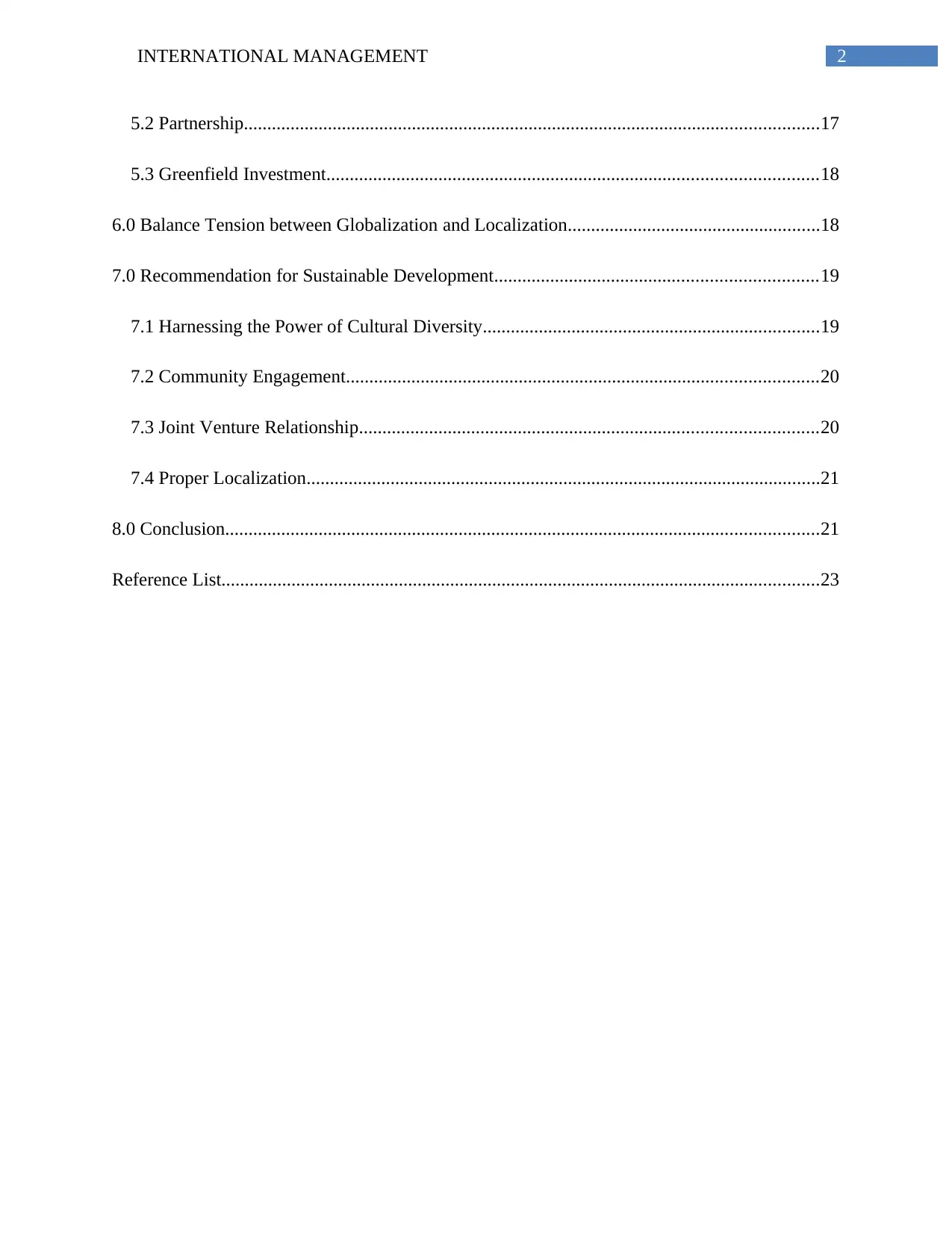
2INTERNATIONAL MANAGEMENT
5.2 Partnership...........................................................................................................................17
5.3 Greenfield Investment.........................................................................................................18
6.0 Balance Tension between Globalization and Localization......................................................18
7.0 Recommendation for Sustainable Development.....................................................................19
7.1 Harnessing the Power of Cultural Diversity........................................................................19
7.2 Community Engagement.....................................................................................................20
7.3 Joint Venture Relationship..................................................................................................20
7.4 Proper Localization..............................................................................................................21
8.0 Conclusion...............................................................................................................................21
Reference List................................................................................................................................23
5.2 Partnership...........................................................................................................................17
5.3 Greenfield Investment.........................................................................................................18
6.0 Balance Tension between Globalization and Localization......................................................18
7.0 Recommendation for Sustainable Development.....................................................................19
7.1 Harnessing the Power of Cultural Diversity........................................................................19
7.2 Community Engagement.....................................................................................................20
7.3 Joint Venture Relationship..................................................................................................20
7.4 Proper Localization..............................................................................................................21
8.0 Conclusion...............................................................................................................................21
Reference List................................................................................................................................23
⊘ This is a preview!⊘
Do you want full access?
Subscribe today to unlock all pages.

Trusted by 1+ million students worldwide
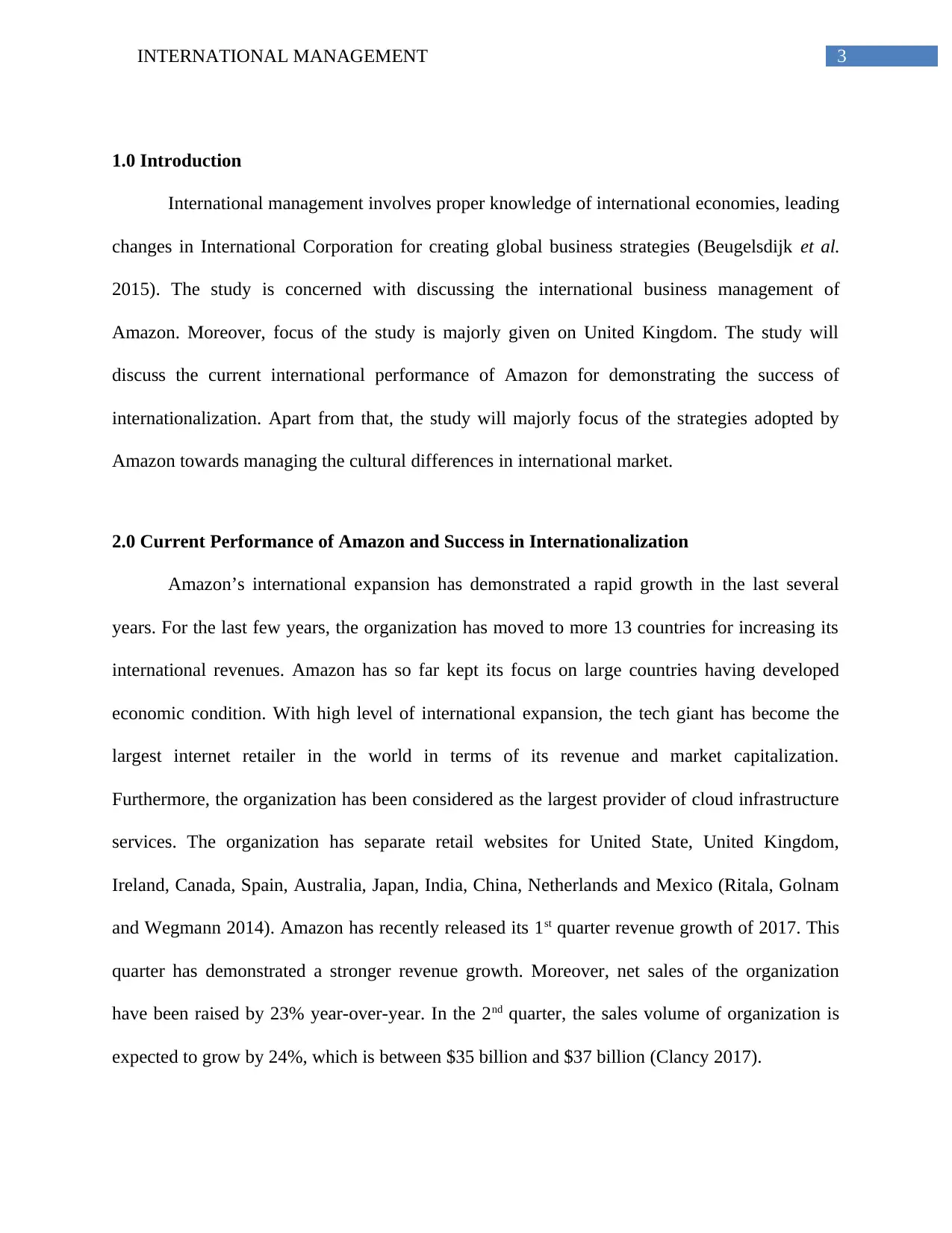
3INTERNATIONAL MANAGEMENT
1.0 Introduction
International management involves proper knowledge of international economies, leading
changes in International Corporation for creating global business strategies (Beugelsdijk et al.
2015). The study is concerned with discussing the international business management of
Amazon. Moreover, focus of the study is majorly given on United Kingdom. The study will
discuss the current international performance of Amazon for demonstrating the success of
internationalization. Apart from that, the study will majorly focus of the strategies adopted by
Amazon towards managing the cultural differences in international market.
2.0 Current Performance of Amazon and Success in Internationalization
Amazon’s international expansion has demonstrated a rapid growth in the last several
years. For the last few years, the organization has moved to more 13 countries for increasing its
international revenues. Amazon has so far kept its focus on large countries having developed
economic condition. With high level of international expansion, the tech giant has become the
largest internet retailer in the world in terms of its revenue and market capitalization.
Furthermore, the organization has been considered as the largest provider of cloud infrastructure
services. The organization has separate retail websites for United State, United Kingdom,
Ireland, Canada, Spain, Australia, Japan, India, China, Netherlands and Mexico (Ritala, Golnam
and Wegmann 2014). Amazon has recently released its 1st quarter revenue growth of 2017. This
quarter has demonstrated a stronger revenue growth. Moreover, net sales of the organization
have been raised by 23% year-over-year. In the 2nd quarter, the sales volume of organization is
expected to grow by 24%, which is between $35 billion and $37 billion (Clancy 2017).
1.0 Introduction
International management involves proper knowledge of international economies, leading
changes in International Corporation for creating global business strategies (Beugelsdijk et al.
2015). The study is concerned with discussing the international business management of
Amazon. Moreover, focus of the study is majorly given on United Kingdom. The study will
discuss the current international performance of Amazon for demonstrating the success of
internationalization. Apart from that, the study will majorly focus of the strategies adopted by
Amazon towards managing the cultural differences in international market.
2.0 Current Performance of Amazon and Success in Internationalization
Amazon’s international expansion has demonstrated a rapid growth in the last several
years. For the last few years, the organization has moved to more 13 countries for increasing its
international revenues. Amazon has so far kept its focus on large countries having developed
economic condition. With high level of international expansion, the tech giant has become the
largest internet retailer in the world in terms of its revenue and market capitalization.
Furthermore, the organization has been considered as the largest provider of cloud infrastructure
services. The organization has separate retail websites for United State, United Kingdom,
Ireland, Canada, Spain, Australia, Japan, India, China, Netherlands and Mexico (Ritala, Golnam
and Wegmann 2014). Amazon has recently released its 1st quarter revenue growth of 2017. This
quarter has demonstrated a stronger revenue growth. Moreover, net sales of the organization
have been raised by 23% year-over-year. In the 2nd quarter, the sales volume of organization is
expected to grow by 24%, which is between $35 billion and $37 billion (Clancy 2017).
Paraphrase This Document
Need a fresh take? Get an instant paraphrase of this document with our AI Paraphraser
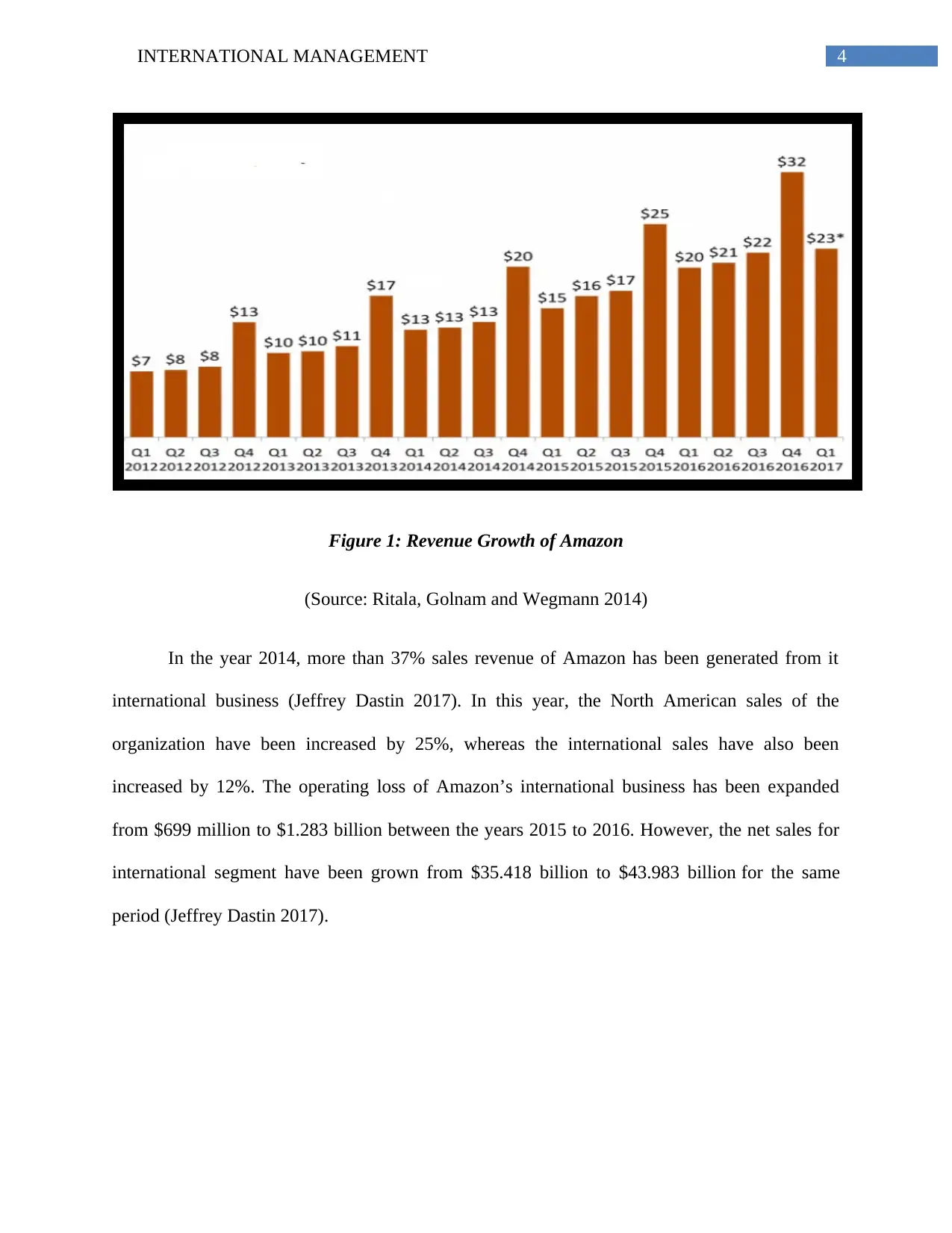
4INTERNATIONAL MANAGEMENT
Figure 1: Revenue Growth of Amazon
(Source: Ritala, Golnam and Wegmann 2014)
In the year 2014, more than 37% sales revenue of Amazon has been generated from it
international business (Jeffrey Dastin 2017). In this year, the North American sales of the
organization have been increased by 25%, whereas the international sales have also been
increased by 12%. The operating loss of Amazon’s international business has been expanded
from $699 million to $1.283 billion between the years 2015 to 2016. However, the net sales for
international segment have been grown from $35.418 billion to $43.983 billion for the same
period (Jeffrey Dastin 2017).
Figure 1: Revenue Growth of Amazon
(Source: Ritala, Golnam and Wegmann 2014)
In the year 2014, more than 37% sales revenue of Amazon has been generated from it
international business (Jeffrey Dastin 2017). In this year, the North American sales of the
organization have been increased by 25%, whereas the international sales have also been
increased by 12%. The operating loss of Amazon’s international business has been expanded
from $699 million to $1.283 billion between the years 2015 to 2016. However, the net sales for
international segment have been grown from $35.418 billion to $43.983 billion for the same
period (Jeffrey Dastin 2017).
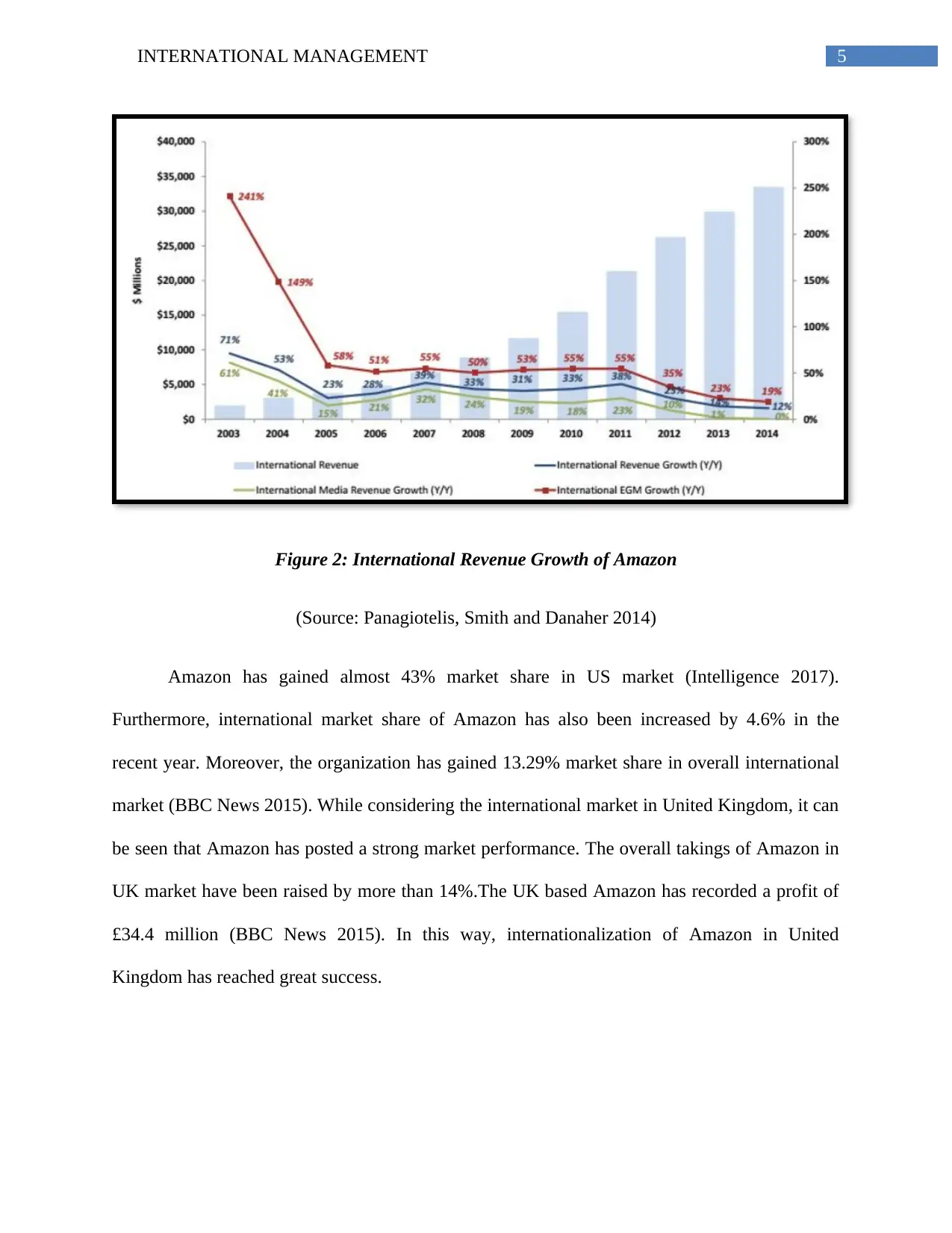
5INTERNATIONAL MANAGEMENT
Figure 2: International Revenue Growth of Amazon
(Source: Panagiotelis, Smith and Danaher 2014)
Amazon has gained almost 43% market share in US market (Intelligence 2017).
Furthermore, international market share of Amazon has also been increased by 4.6% in the
recent year. Moreover, the organization has gained 13.29% market share in overall international
market (BBC News 2015). While considering the international market in United Kingdom, it can
be seen that Amazon has posted a strong market performance. The overall takings of Amazon in
UK market have been raised by more than 14%.The UK based Amazon has recorded a profit of
£34.4 million (BBC News 2015). In this way, internationalization of Amazon in United
Kingdom has reached great success.
Figure 2: International Revenue Growth of Amazon
(Source: Panagiotelis, Smith and Danaher 2014)
Amazon has gained almost 43% market share in US market (Intelligence 2017).
Furthermore, international market share of Amazon has also been increased by 4.6% in the
recent year. Moreover, the organization has gained 13.29% market share in overall international
market (BBC News 2015). While considering the international market in United Kingdom, it can
be seen that Amazon has posted a strong market performance. The overall takings of Amazon in
UK market have been raised by more than 14%.The UK based Amazon has recorded a profit of
£34.4 million (BBC News 2015). In this way, internationalization of Amazon in United
Kingdom has reached great success.
⊘ This is a preview!⊘
Do you want full access?
Subscribe today to unlock all pages.

Trusted by 1+ million students worldwide
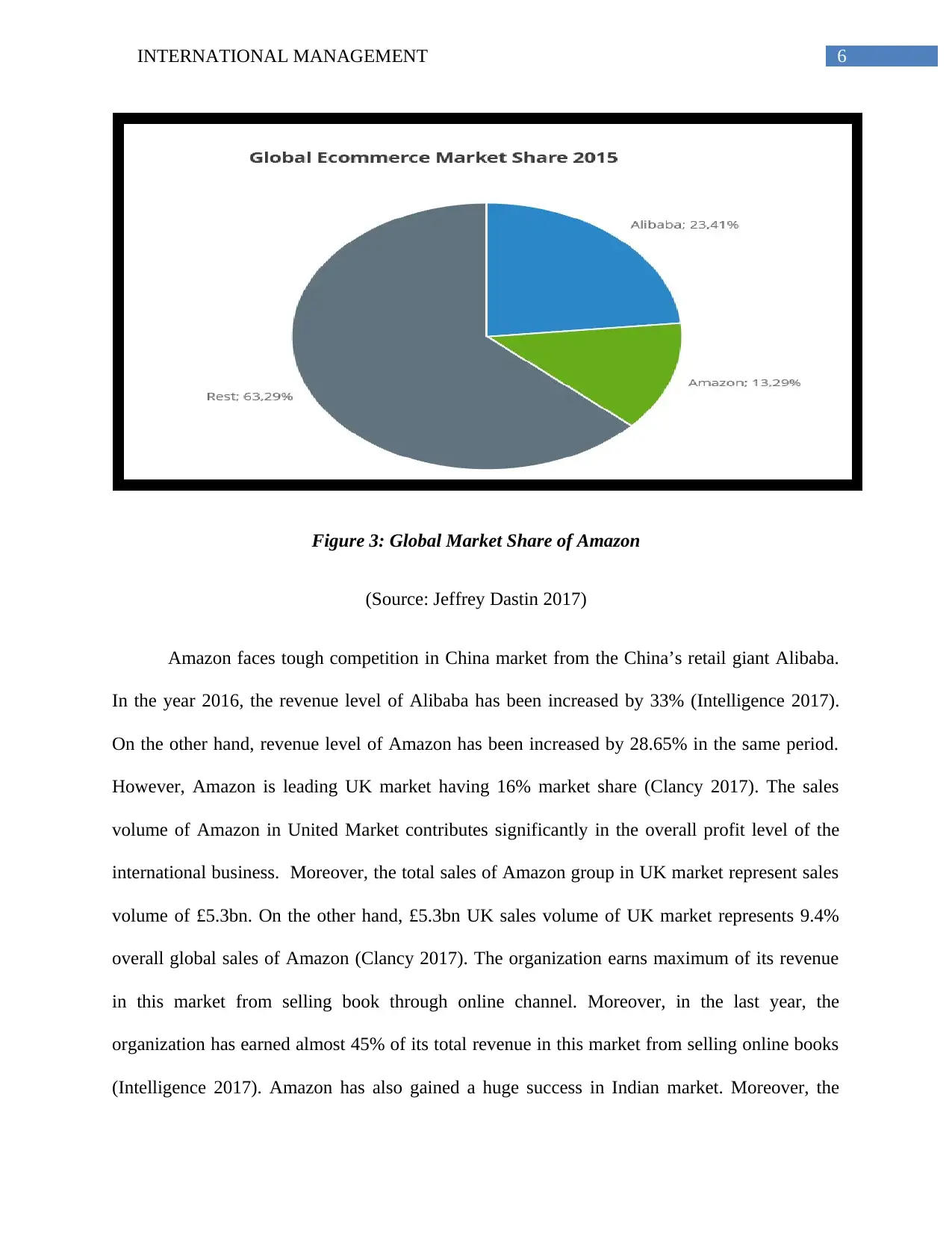
6INTERNATIONAL MANAGEMENT
Figure 3: Global Market Share of Amazon
(Source: Jeffrey Dastin 2017)
Amazon faces tough competition in China market from the China’s retail giant Alibaba.
In the year 2016, the revenue level of Alibaba has been increased by 33% (Intelligence 2017).
On the other hand, revenue level of Amazon has been increased by 28.65% in the same period.
However, Amazon is leading UK market having 16% market share (Clancy 2017). The sales
volume of Amazon in United Market contributes significantly in the overall profit level of the
international business. Moreover, the total sales of Amazon group in UK market represent sales
volume of £5.3bn. On the other hand, £5.3bn UK sales volume of UK market represents 9.4%
overall global sales of Amazon (Clancy 2017). The organization earns maximum of its revenue
in this market from selling book through online channel. Moreover, in the last year, the
organization has earned almost 45% of its total revenue in this market from selling online books
(Intelligence 2017). Amazon has also gained a huge success in Indian market. Moreover, the
Figure 3: Global Market Share of Amazon
(Source: Jeffrey Dastin 2017)
Amazon faces tough competition in China market from the China’s retail giant Alibaba.
In the year 2016, the revenue level of Alibaba has been increased by 33% (Intelligence 2017).
On the other hand, revenue level of Amazon has been increased by 28.65% in the same period.
However, Amazon is leading UK market having 16% market share (Clancy 2017). The sales
volume of Amazon in United Market contributes significantly in the overall profit level of the
international business. Moreover, the total sales of Amazon group in UK market represent sales
volume of £5.3bn. On the other hand, £5.3bn UK sales volume of UK market represents 9.4%
overall global sales of Amazon (Clancy 2017). The organization earns maximum of its revenue
in this market from selling book through online channel. Moreover, in the last year, the
organization has earned almost 45% of its total revenue in this market from selling online books
(Intelligence 2017). Amazon has also gained a huge success in Indian market. Moreover, the
Paraphrase This Document
Need a fresh take? Get an instant paraphrase of this document with our AI Paraphraser
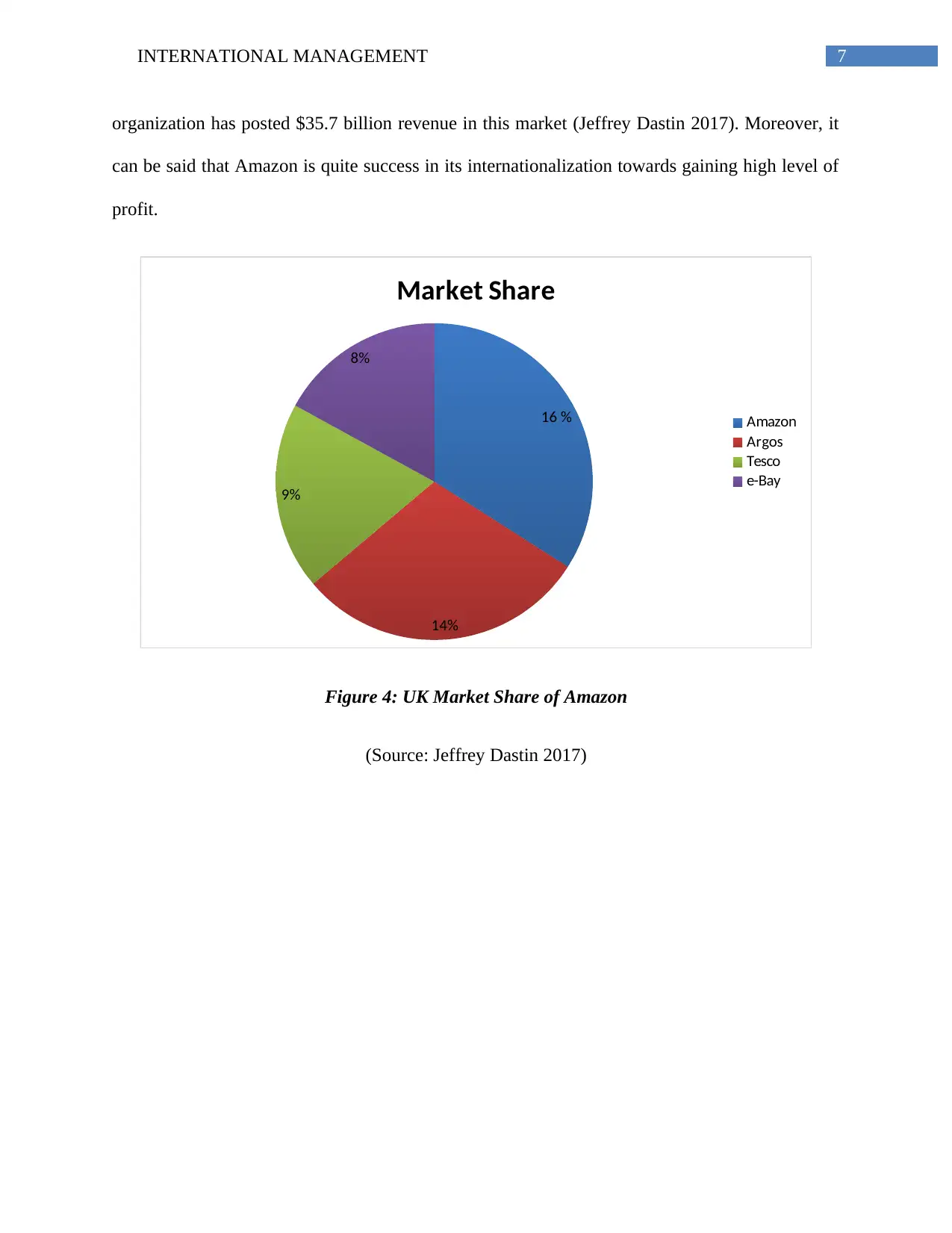
7INTERNATIONAL MANAGEMENT
organization has posted $35.7 billion revenue in this market (Jeffrey Dastin 2017). Moreover, it
can be said that Amazon is quite success in its internationalization towards gaining high level of
profit.
16 %
14%
9%
8%
Market Share
Amazon
Argos
Tesco
e-Bay
Figure 4: UK Market Share of Amazon
(Source: Jeffrey Dastin 2017)
organization has posted $35.7 billion revenue in this market (Jeffrey Dastin 2017). Moreover, it
can be said that Amazon is quite success in its internationalization towards gaining high level of
profit.
16 %
14%
9%
8%
Market Share
Amazon
Argos
Tesco
e-Bay
Figure 4: UK Market Share of Amazon
(Source: Jeffrey Dastin 2017)
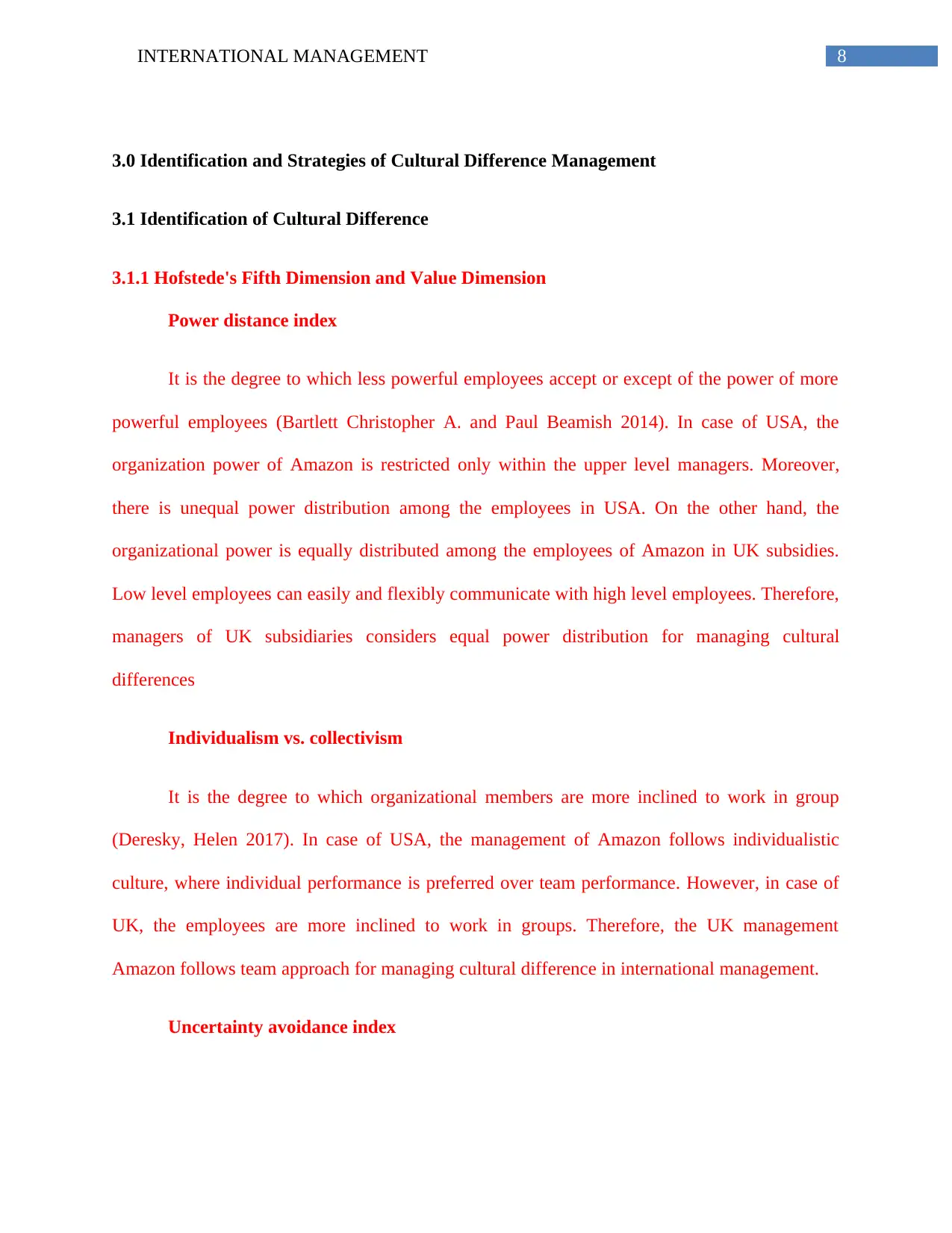
8INTERNATIONAL MANAGEMENT
3.0 Identification and Strategies of Cultural Difference Management
3.1 Identification of Cultural Difference
3.1.1 Hofstede's Fifth Dimension and Value Dimension
Power distance index
It is the degree to which less powerful employees accept or except of the power of more
powerful employees (Bartlett Christopher A. and Paul Beamish 2014). In case of USA, the
organization power of Amazon is restricted only within the upper level managers. Moreover,
there is unequal power distribution among the employees in USA. On the other hand, the
organizational power is equally distributed among the employees of Amazon in UK subsidies.
Low level employees can easily and flexibly communicate with high level employees. Therefore,
managers of UK subsidiaries considers equal power distribution for managing cultural
differences
Individualism vs. collectivism
It is the degree to which organizational members are more inclined to work in group
(Deresky, Helen 2017). In case of USA, the management of Amazon follows individualistic
culture, where individual performance is preferred over team performance. However, in case of
UK, the employees are more inclined to work in groups. Therefore, the UK management
Amazon follows team approach for managing cultural difference in international management.
Uncertainty avoidance index
3.0 Identification and Strategies of Cultural Difference Management
3.1 Identification of Cultural Difference
3.1.1 Hofstede's Fifth Dimension and Value Dimension
Power distance index
It is the degree to which less powerful employees accept or except of the power of more
powerful employees (Bartlett Christopher A. and Paul Beamish 2014). In case of USA, the
organization power of Amazon is restricted only within the upper level managers. Moreover,
there is unequal power distribution among the employees in USA. On the other hand, the
organizational power is equally distributed among the employees of Amazon in UK subsidies.
Low level employees can easily and flexibly communicate with high level employees. Therefore,
managers of UK subsidiaries considers equal power distribution for managing cultural
differences
Individualism vs. collectivism
It is the degree to which organizational members are more inclined to work in group
(Deresky, Helen 2017). In case of USA, the management of Amazon follows individualistic
culture, where individual performance is preferred over team performance. However, in case of
UK, the employees are more inclined to work in groups. Therefore, the UK management
Amazon follows team approach for managing cultural difference in international management.
Uncertainty avoidance index
⊘ This is a preview!⊘
Do you want full access?
Subscribe today to unlock all pages.

Trusted by 1+ million students worldwide
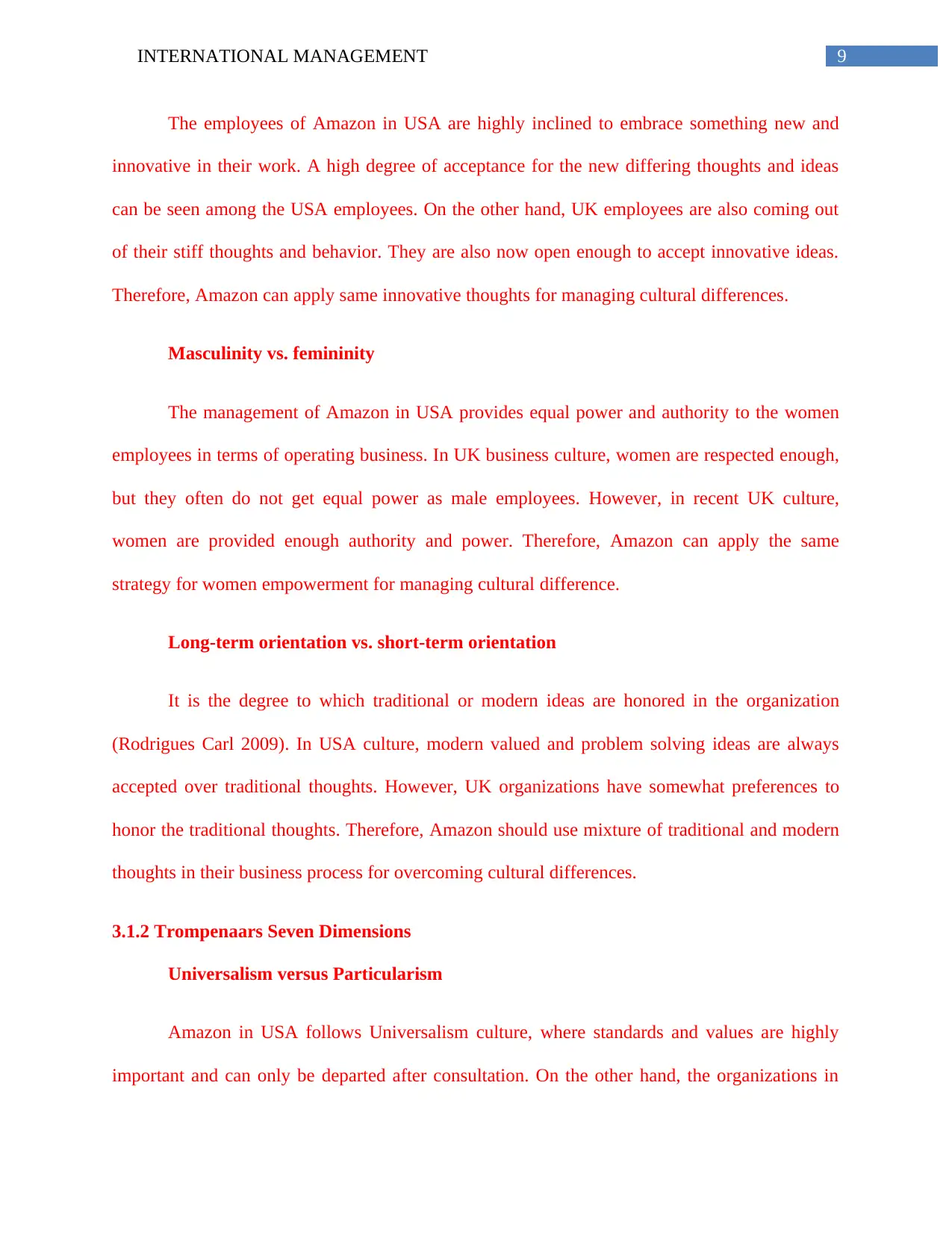
9INTERNATIONAL MANAGEMENT
The employees of Amazon in USA are highly inclined to embrace something new and
innovative in their work. A high degree of acceptance for the new differing thoughts and ideas
can be seen among the USA employees. On the other hand, UK employees are also coming out
of their stiff thoughts and behavior. They are also now open enough to accept innovative ideas.
Therefore, Amazon can apply same innovative thoughts for managing cultural differences.
Masculinity vs. femininity
The management of Amazon in USA provides equal power and authority to the women
employees in terms of operating business. In UK business culture, women are respected enough,
but they often do not get equal power as male employees. However, in recent UK culture,
women are provided enough authority and power. Therefore, Amazon can apply the same
strategy for women empowerment for managing cultural difference.
Long-term orientation vs. short-term orientation
It is the degree to which traditional or modern ideas are honored in the organization
(Rodrigues Carl 2009). In USA culture, modern valued and problem solving ideas are always
accepted over traditional thoughts. However, UK organizations have somewhat preferences to
honor the traditional thoughts. Therefore, Amazon should use mixture of traditional and modern
thoughts in their business process for overcoming cultural differences.
3.1.2 Trompenaars Seven Dimensions
Universalism versus Particularism
Amazon in USA follows Universalism culture, where standards and values are highly
important and can only be departed after consultation. On the other hand, the organizations in
The employees of Amazon in USA are highly inclined to embrace something new and
innovative in their work. A high degree of acceptance for the new differing thoughts and ideas
can be seen among the USA employees. On the other hand, UK employees are also coming out
of their stiff thoughts and behavior. They are also now open enough to accept innovative ideas.
Therefore, Amazon can apply same innovative thoughts for managing cultural differences.
Masculinity vs. femininity
The management of Amazon in USA provides equal power and authority to the women
employees in terms of operating business. In UK business culture, women are respected enough,
but they often do not get equal power as male employees. However, in recent UK culture,
women are provided enough authority and power. Therefore, Amazon can apply the same
strategy for women empowerment for managing cultural difference.
Long-term orientation vs. short-term orientation
It is the degree to which traditional or modern ideas are honored in the organization
(Rodrigues Carl 2009). In USA culture, modern valued and problem solving ideas are always
accepted over traditional thoughts. However, UK organizations have somewhat preferences to
honor the traditional thoughts. Therefore, Amazon should use mixture of traditional and modern
thoughts in their business process for overcoming cultural differences.
3.1.2 Trompenaars Seven Dimensions
Universalism versus Particularism
Amazon in USA follows Universalism culture, where standards and values are highly
important and can only be departed after consultation. On the other hand, the organizations in
Paraphrase This Document
Need a fresh take? Get an instant paraphrase of this document with our AI Paraphraser
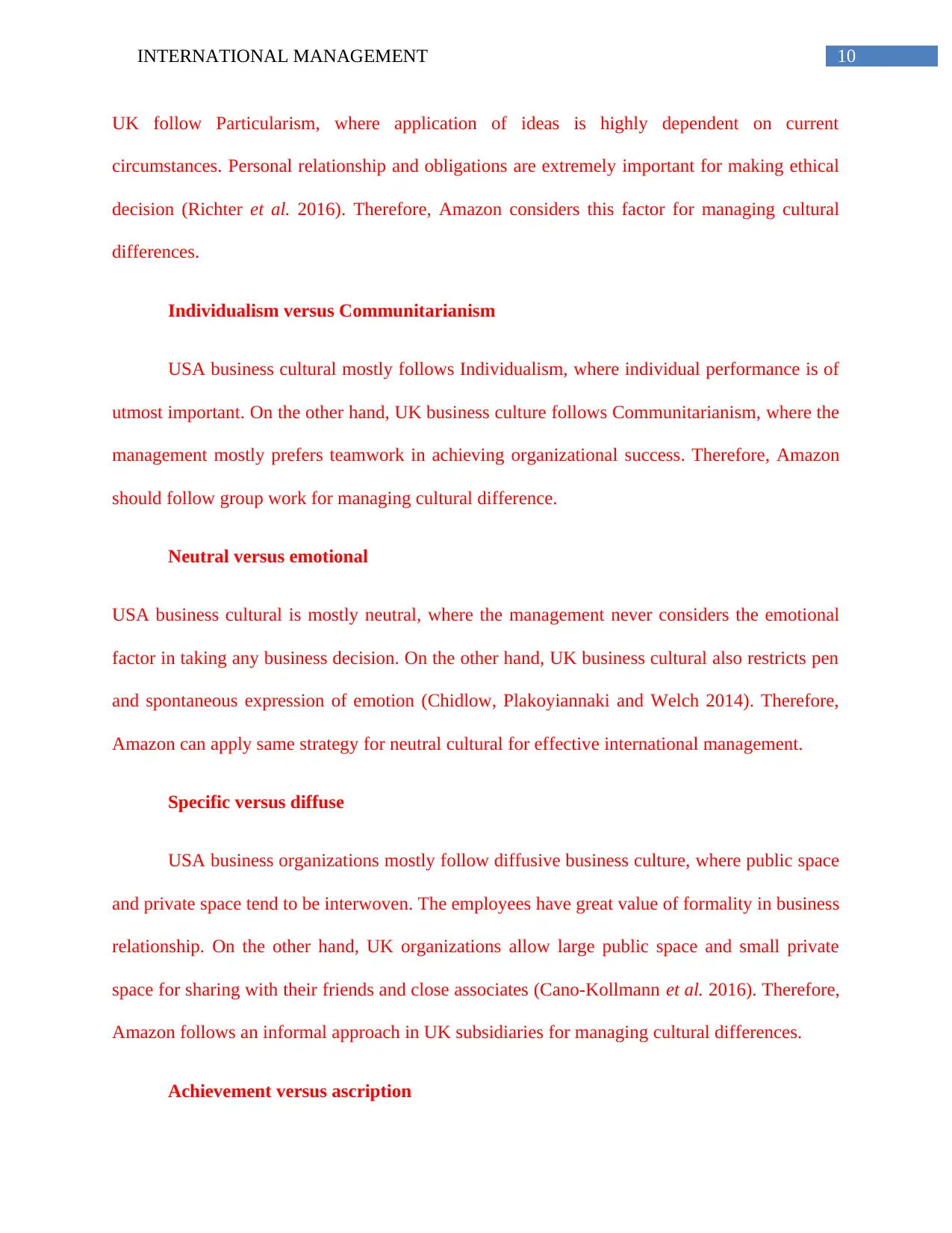
10INTERNATIONAL MANAGEMENT
UK follow Particularism, where application of ideas is highly dependent on current
circumstances. Personal relationship and obligations are extremely important for making ethical
decision (Richter et al. 2016). Therefore, Amazon considers this factor for managing cultural
differences.
Individualism versus Communitarianism
USA business cultural mostly follows Individualism, where individual performance is of
utmost important. On the other hand, UK business culture follows Communitarianism, where the
management mostly prefers teamwork in achieving organizational success. Therefore, Amazon
should follow group work for managing cultural difference.
Neutral versus emotional
USA business cultural is mostly neutral, where the management never considers the emotional
factor in taking any business decision. On the other hand, UK business cultural also restricts pen
and spontaneous expression of emotion (Chidlow, Plakoyiannaki and Welch 2014). Therefore,
Amazon can apply same strategy for neutral cultural for effective international management.
Specific versus diffuse
USA business organizations mostly follow diffusive business culture, where public space
and private space tend to be interwoven. The employees have great value of formality in business
relationship. On the other hand, UK organizations allow large public space and small private
space for sharing with their friends and close associates (Cano-Kollmann et al. 2016). Therefore,
Amazon follows an informal approach in UK subsidiaries for managing cultural differences.
Achievement versus ascription
UK follow Particularism, where application of ideas is highly dependent on current
circumstances. Personal relationship and obligations are extremely important for making ethical
decision (Richter et al. 2016). Therefore, Amazon considers this factor for managing cultural
differences.
Individualism versus Communitarianism
USA business cultural mostly follows Individualism, where individual performance is of
utmost important. On the other hand, UK business culture follows Communitarianism, where the
management mostly prefers teamwork in achieving organizational success. Therefore, Amazon
should follow group work for managing cultural difference.
Neutral versus emotional
USA business cultural is mostly neutral, where the management never considers the emotional
factor in taking any business decision. On the other hand, UK business cultural also restricts pen
and spontaneous expression of emotion (Chidlow, Plakoyiannaki and Welch 2014). Therefore,
Amazon can apply same strategy for neutral cultural for effective international management.
Specific versus diffuse
USA business organizations mostly follow diffusive business culture, where public space
and private space tend to be interwoven. The employees have great value of formality in business
relationship. On the other hand, UK organizations allow large public space and small private
space for sharing with their friends and close associates (Cano-Kollmann et al. 2016). Therefore,
Amazon follows an informal approach in UK subsidiaries for managing cultural differences.
Achievement versus ascription
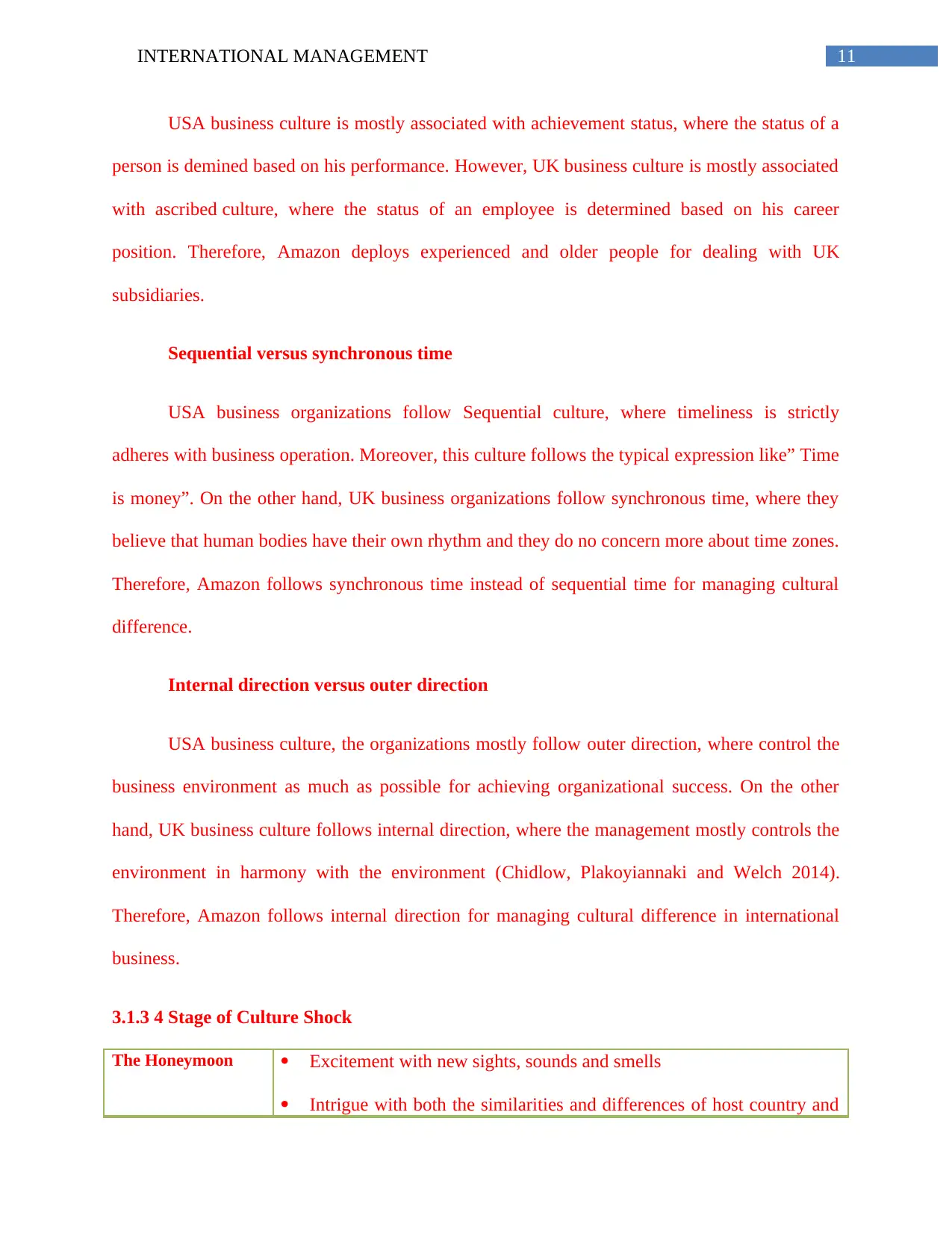
11INTERNATIONAL MANAGEMENT
USA business culture is mostly associated with achievement status, where the status of a
person is demined based on his performance. However, UK business culture is mostly associated
with ascribed culture, where the status of an employee is determined based on his career
position. Therefore, Amazon deploys experienced and older people for dealing with UK
subsidiaries.
Sequential versus synchronous time
USA business organizations follow Sequential culture, where timeliness is strictly
adheres with business operation. Moreover, this culture follows the typical expression like” Time
is money”. On the other hand, UK business organizations follow synchronous time, where they
believe that human bodies have their own rhythm and they do no concern more about time zones.
Therefore, Amazon follows synchronous time instead of sequential time for managing cultural
difference.
Internal direction versus outer direction
USA business culture, the organizations mostly follow outer direction, where control the
business environment as much as possible for achieving organizational success. On the other
hand, UK business culture follows internal direction, where the management mostly controls the
environment in harmony with the environment (Chidlow, Plakoyiannaki and Welch 2014).
Therefore, Amazon follows internal direction for managing cultural difference in international
business.
3.1.3 4 Stage of Culture Shock
The Honeymoon Excitement with new sights, sounds and smells
Intrigue with both the similarities and differences of host country and
USA business culture is mostly associated with achievement status, where the status of a
person is demined based on his performance. However, UK business culture is mostly associated
with ascribed culture, where the status of an employee is determined based on his career
position. Therefore, Amazon deploys experienced and older people for dealing with UK
subsidiaries.
Sequential versus synchronous time
USA business organizations follow Sequential culture, where timeliness is strictly
adheres with business operation. Moreover, this culture follows the typical expression like” Time
is money”. On the other hand, UK business organizations follow synchronous time, where they
believe that human bodies have their own rhythm and they do no concern more about time zones.
Therefore, Amazon follows synchronous time instead of sequential time for managing cultural
difference.
Internal direction versus outer direction
USA business culture, the organizations mostly follow outer direction, where control the
business environment as much as possible for achieving organizational success. On the other
hand, UK business culture follows internal direction, where the management mostly controls the
environment in harmony with the environment (Chidlow, Plakoyiannaki and Welch 2014).
Therefore, Amazon follows internal direction for managing cultural difference in international
business.
3.1.3 4 Stage of Culture Shock
The Honeymoon Excitement with new sights, sounds and smells
Intrigue with both the similarities and differences of host country and
⊘ This is a preview!⊘
Do you want full access?
Subscribe today to unlock all pages.

Trusted by 1+ million students worldwide
1 out of 27
Related Documents
Your All-in-One AI-Powered Toolkit for Academic Success.
+13062052269
info@desklib.com
Available 24*7 on WhatsApp / Email
![[object Object]](/_next/static/media/star-bottom.7253800d.svg)
Unlock your academic potential
Copyright © 2020–2025 A2Z Services. All Rights Reserved. Developed and managed by ZUCOL.





